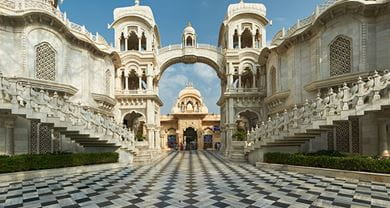- Trending:
- Easter
- |
- Lent
- |
- Forgiveness
- |
- Resurrection
- |
- Joy
- |
- Feminism

RELIGION LIBRARY
ISKCON (Hare Krishna)
Early Developments
ISKCON originated as a new religious movement centered on the preaching of its charismatic leader, A.C. Bhaktivedanta Swami Prabhupada. Prabhupada's death on November 14, 1977 shook the very nature of the movement, catapulting some of his disciples into the role of gurus. Some of these new gurus performed admirably, seeking to hold the group together and continue the work of ISKCON's founder. Others, however, lacked leadership skills or the strength of character to serve a lifetime as celibate monastics.
Already in his 70s by the time ISKCON had established itself as an international religious movement, Bhaktivedanta had prepared his disciples for their transition to becoming gurus by assigning them a variety of leadership roles. Even before his death, Bhaktivedanta's Western converts ran the group's book publishing arm, wrote and edited the movement's Back to Godhead magazine, served as temple presidents, and oversaw growth of the movement into new regions. Though few possessed any training in running a multinational institution, religious or otherwise, through on-the-job experience these disciples -- mostly young men whom Bhaktivedanta had attracted out of the hippie subculture -- slowly trained themselves as religious bureaucrats.
Prabhupada's passing left three distinct groups at the helm of the movement, each comprised almost exclusively of the Hare Krishna movement's elite: male devotees who had taken the sannyasi vows of renunciation, eschewing family, friends, and wealth in order to focus exclusively on the work of the International Society for Krishna Consciousness. The first of these new leaders were the trustees of the movement's trusts and independently incorporated divisions. Foremost of these, the Bhaktivedanta Book Trust owned the copyrights on Bhaktivedanta's translations and commentaries on the Bhagavadgita and Bhagavata Purana, and his many other writings. Because ISKCON's main revenue source derived from the sale of books, the Bhaktivedanta Book Trust became one of the more powerful institutions in the post-Prabhupada era, and its trustees and editors exerted heightened influence over the movement.
Yet the most important institution to emerge to lead ISKCON was the Governing Body Commission (GBC), a group that Bhaktivedanta established before his death in order to oversee the worldly affairs of the movement, including its recruitment efforts, finances, and political decisions regarding the group's future. Comprised originally of twelve senior male devotees, by the time of Bhaktivedanta's death, the GBC had expanded to eighteen members, all of them male and most of them celibate. In his will, Bhaktivedanta charged the GBC to not only oversee ISKCON, but to serve as his successor and its leader.
During his protracted illness shortly before his death, Bhaktivedanta also appointed eleven senior male devotees -- all celibates who had taken the sannyasi vows of renunciation -- as what he called "ritviks," a technical Sanskrit term for officiating priests. The precise history and details are a matter of debate within ISKCON, with some schools of thought believing that Prabhupada meant for these ritviks to serve only in his stead during Prabhupada's illness, and others believing that the founder intended them to become full-fledged gurus after his death. The latter approach won the day, and after 1977, these eleven gurus assumed the religious leadership of the Hare Krishna movement.
The eleven gurus created what came to be called the "zonal acharya system." Though the Sanskrit word acharya has several meanings, in the Gaudiya Vaishnavas lineage, it generally refers to a guru who is also a singular leader of a religious sect as well as a model of the highest modes of bhakti, or devotion. Bhaktivedanta had served as ISKCON acharya, and in keeping with this approach, the eleven new gurus divided the movement into eleven distinct geographic regions. In each of these regions a single guru served as acharya, meaning that he both had religious authority, and controlled the institutional bureaucracy -- including finances and personnel decisions -- for that region.
The zonal acharya system was ultimately untenable, though it lasted a decade. For one, the gurus' claims over the institution conflicted with Prabhupada's clear instructions that the Governing Body Commission was to oversee ISKCON. However, because the eleven gurus also served as a supermajority within the GBC, they were able to exert a high level of control over the movement for many years. Over time, their management began to show signs of stress. Though some were good leaders, many lacked the skills to direct a sprawling religious organization, and several others engaged in illicit and even criminal activities. In some cases, they offered substantially different teachings than one another, in affect creating multiple Hare Krishna sub-movements throughout the world. During the 1980s, the GBC suspended and eventually removed from office most of the gurus who had engaged in drug use, sexual activity, and in some cases felonious criminal activity. In some cases, the gurus left ISKCON, or founded their own sectarian organizations. By the time of this writing, only two of the eleven zonal gurus remain in good standing as ISKCON gurus.
In 1987, the GBC terminated the zonal acharya system, permanently removing from office the disgraced gurus, stripping the remaining gurus of bureaucratic control, permitting the elevation of new gurus, and appointing fifteen new members -- all opponents of the zonal acharya system -- to the GBC itself. Though the decade-long transition resulted in significant defection (by some counts, four-fifths of Prabhupada's disciples had left the movement by 1987), the eventual settlement allowed ISKCON to structure itself as a modern corporate institution. Today the Governing Body Commission oversees the financial, institutional, and political issues facing ISKCON, while a wide array of gurus, about eighty of whom now operate worldwide, provide religious leadership.
Study Questions:
1. What was the role of gurus in the continuation of ISKCON after Bhaktivedanta's death?
2. Did the role of capitalism play a role in the success of ISKCON? Why or why not?
3. What is ISKCON's Governing Body Commission?
4. What was the Zonal Acharya System? Why was it terminated?










